
The dark matter of biology: clumps of sugar molecules that, for example, form sugary webs around pathogens. We know very little about them. Wouter Remmerswaal threw all his talent into the challenge - both in the lab and as a modeller - and succeeded. He received his PhD on 12th September.
Think of them as letters: sugar molecules. There are only a few dozen different types, but when you string them together, you can create countless combinations. In sugar chemistry, scientists try to replicate these complex sugars precisely because they play an important role in biology. For example, bacteria have a sugary coating around their cell wall: a kind of cotton candy that hides the proteins by which our immune system can recognise them.

Small difference, big impact
Sugar chemistry is a complex field where small, subtle differences in sugar structures can have significant consequences. Chemist Wouter Remmerswaal gives an example: 'If long chains of glucose molecules are linked side by side - we call this beta-linkage - it becomes the indigestible plant fibre cellulose. If they are linked end to end - alpha-linkage - you get starch.' This principle also applies to the complex sugars made by bacteria: a different linkage gives the sugar an entirely different function.
Darting with fewer darts
Researchers still don't fully understand how sugars link to one another and why. That's why it's difficult, for example, to obtain the specific sugar chain needed to study an immune response to that chain. Remmerswaal explains: 'The usual approach is the dartboard strategy. You try ten things and hope something works. The more we understand, the fewer darts are needed.'
'I specialised in both laboratory work and modelling, a rare combination in one person.'
Remmerswaal succeeded in reducing the number of darts required for several sugar reactions. How did he manage that? The key to his success, Remmerswaal believes, is his dual specialisation. 'I specialised in both laboratory work and modelling, a rare combination in one person.' He tried many strategies, both in the lab and using modelling programmes. He thoroughly enjoyed working on it. 'After a regular workday, I often continued at my computer in the evening.' But the input from others was also crucial: 'I collaborated a lot with people who could bring in other skills, such as physical chemists who work with infrared radiation.'

Back to the bigger picture
When asked whether there were any setbacks or significant challenges, Remmerswaal takes a moment to reflect. 'I was lucky to get results quite early on, and I was able to publish work where I was the first author. Once that's done, the pressure is off. The biggest challenge was probably keeping the bigger picture in mind and not getting too bogged down in the details.' Remmerswaal, who also enjoys chess, preferred to puzzle through problems until he understood them fully. 'But you need to keep in mind what's still important for the research field.'
Adding tools to the toolbox
Remmerswaal is now a postdoctoral researcher at Uppsala University in Sweden. 'I absolutely love sugars, but here I'm working on asymmetric halogenation: adding a halogen to a molecule at a specific, non-symmetrical position. Again, we're investigating how to get the one compound we need from the two possibilities. I can once again apply my experience with both computers and lab work, and I'm learning new techniques to expand my toolbox.'
Header image: Pseudomonas bacteria are protected by a complex sugar layer.

Thesis and defense
Wouter Remmerswaal received his PhD on 12 September 2024 with the thesis'Computational and Experimental Studies of Reactive Intermediates in Glycosylation Reactions'. His supervisors were Jeroen Codée and Thomas Hansen (VU Amsterdam).
Further reading
Sciencelink.net: SN2 takes a different approach






